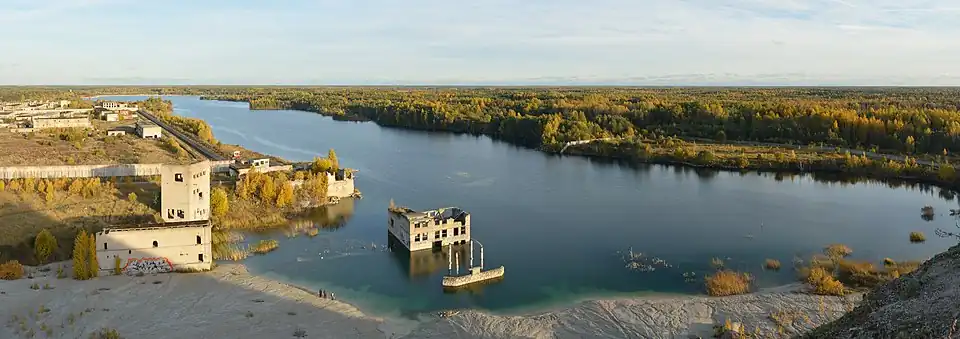Quarry lake

A quarry lake, also known as a pit lake, is a lake that is formed after a quarry has been dug through a mining operation.
Formation
During the mining process, water must be emptied. But after the mining operation has been abandoned, groundwater is allowed to seep in, and rainwater collects in the quarry. The depth of a quarry lake is dependent upon rainfall in the region.[1]
Hazards to humans
Water-filled quarries can be very deep, often 50 ft (15 m) or more, and surprisingly cold, so swimming in quarry lakes is generally not recommended. Unexpectedly cold water[2] can cause a swimmer's muscles to suddenly weaken; it can also cause shock, cold water shock[2] and even hypothermia.[3] Though quarry water is often very clear, submerged quarry stones and abandoned equipment make diving and jumping into these quarries extremely dangerous. Several people drown in quarries each year.[4][2] Water-filled quarries can have dangerous electric currents in them that can be deadly under water.[5]
Geology.com cites Mine Safety and Health Administration data in saying that between 2001 and 2017, there were 201 drowning deaths in abandoned mines in the United States, or around twelve per year;[2] statistics from the Centers for Disease Control indicate that each year there are 3,960 drowning deaths.[6]
Ecology
Quarry lakes, even lakes within active quarries, can provide important habitats for animals.[7]
By country
Switzerland
In Switzerland, quarry lakes have been prohibited since the 1990s, contrasting sharply with the widespread acceptance of such recreational facilities in neighboring Germany and France. The prohibition stems from strict groundwater protection regulations designed to safeguard the country's drinking water supply.[8]
Swiss regulations require maintaining a "dry protective layer" of several meters of gravel above the maximum possible groundwater level. This prevents direct contact between surface water and groundwater, which occurs naturally in quarry lakes elsewhere. This approach prioritizes groundwater protection due to concerns about contamination from recreational activities. Potential pollutants include sunscreen chemicals from swimmers and human waste, which could infiltrate the groundwater system. Groundwater contamination is often irreversible, making rehabilitation extremely difficult once pollution occurs.[8]
Rather than creating quarry lakes, exhausted Swiss gravel pits are typically restored to their original state as agricultural land or forests. Some areas are converted into artificial wetlands that serve as habitats for protected species such as the yellow-bellied toad (Bombina variegata) and other wildlife.[8]
Despite the general prohibition, some artificial swimming lakes do exist. The lake at Kriessern in the Rhine Valley of Canton of St. Gallen was created after gravel extraction in the 1920s, predating the current regulations. Similarly, Geschinersee in the Conches Valley of Canton of Valais was constructed in 2003, but it is fed by a stream rather than groundwater.[8]
References
- ^ Chang, Ni-Bin (17 June 2010). Effects of Urbanization on Groundwater: An Engineering Case-Based Approach ... American Society of Civil Engineers. pp. 33–34. ISBN 9780784410783. Retrieved May 31, 2012.
- ^ a b c d "Abandoned Mine and Quarry Accidents Claim Several Lives per Year". Geology.com. 2007-11-03. Retrieved 2012-05-14.
- ^ "American Canoe Association explanation of cold shock". Enter.net. Archived from the original on 2012-06-16. Retrieved 2012-05-14.
- ^ "US Dept. of Labor list of mine related fatalities". Msha.gov. Archived from the original on 2012-03-09. Retrieved 2012-05-14.
- ^ "Stay Out - Stay Alive". US Department of Labour. Archived from the original on 1 December 2021. Retrieved 15 March 2022.
- ^ "Drowning Data | Drowning Prevention | CDC". 17 June 2021.
- ^ Sievers, Michael (19 May 2017). "Sand quarry wetlands provide high-quality habitat for native amphibians". Web Ecology. 17 (1): 19–27. doi:10.5194/we-17-19-2017. hdl:10072/411143.
- ^ a b c d "Le lac de gravière, populaire en France et en Allemagne, mais interdit de baignade en Suisse". rts.ch (in French). 2025-08-17. Retrieved 2025-08-18.
External links
 Media related to Quarry lakes at Wikimedia Commons
Media related to Quarry lakes at Wikimedia Commons
